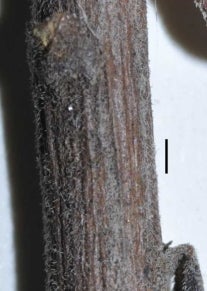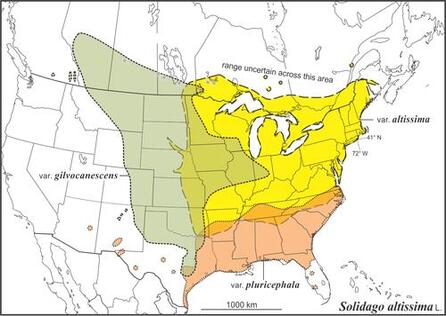Department of Biology
ESC 350
200 University Ave. W
Waterloo, Ontario, Canada N2L 3G1
Phone: (519) 888-4567 ext. 32569
Fax: (519) 746-0614
Late goldenrod , verge d’or haute
 Solidago altissima L. is the most common goldenrod of the Great Plains and eastern North America. It is distinguished by it short-hairy pubescence on the stems and leaves, its usually entire upper stem leaves that are thicker than the serrate upper stem leaves of S. canadensis (Semple & Cook 2006 FNA). Ploidy-level influenced traits have been used to separate the species from related taxa in floras where diploid and hexaploids are being compared. In areas where diploids, tetraploids and hexaploids of S. altissima occur sympatrically, then a trait like involucre height does not facilitate separation of taxa of equal ploidy levels.
Solidago altissima L. is the most common goldenrod of the Great Plains and eastern North America. It is distinguished by it short-hairy pubescence on the stems and leaves, its usually entire upper stem leaves that are thicker than the serrate upper stem leaves of S. canadensis (Semple & Cook 2006 FNA). Ploidy-level influenced traits have been used to separate the species from related taxa in floras where diploid and hexaploids are being compared. In areas where diploids, tetraploids and hexaploids of S. altissima occur sympatrically, then a trait like involucre height does not facilitate separation of taxa of equal ploidy levels.
Solidago altissima is the goldenrod that usually has the mid to upper stem ball galls caused by the Eurosta flies in the family Tephritidae. Rarely these can be seen on S. gigantea, which has its own lower stem gall parasites. Solidago altissima/insect relationships have been studied many times (e.g., Weis and Abrahamson 1986; Halverson et al. 2008b). The ecological literature on various aspects of S. altissima is too large to reference here.
Semple & Cook (2006 FNA) divided the species into two subspecies. More work by Semple et al. (2015) presented multivariate support for recognizing three varieties generally native to the eastern Canada and the northeastern quarter of the U.S., the southeastern U.S., and the Great Plains and Prairie Peninsula. Details of the range are still being clarified; published distribution maps do not separate var. pluricephala at all, and the literature reports distributions at the species level or at the subsp./var. level under multiple synonyms. In areas where varietal ranges are sympatric, the literature offers little to facilitate mapping via the internet and literature. Halverson et al. (2008a) noted the likely multiple origins of polyploids in S. altissima. Semple et al. (2015) discussed this in light of the recognized races in the species. Semple (2022) included a key to the the varieties of S. altissima and S. canadensis.

Solidago altissima is a very weedy species and has become invasive in eastern and southern Asia and Australia and has been documented as present in China (Chen and Semple 2011), Japan (Sakata et al. 2015), Africa (Cheek and Semple 2016), India (Semple and Sankara Rao 2017), Europe (Verloove et al. 2017), Oceana and Australia (Semple and Uesugi 2017), and Turkey (Semple and Yaşayacak 2024).
Solidago altissima was compared in a multivariate study to a number of Mexican species in the protologue of S. veracruzensis Semple (2018), which can be generally similar to S. altissima, particularly var. pluricephala.
The cytogeography of Solidago altissima was summarized and mapped in Semple (2022) based on 520 published chromosome counts for members of the species. The ranges of the three varieties were shown. Diploids 2n=18 only occur in var. gilvocanescens, tetraploids 2n=36 and hexaploids 2n=54 occur in all three varieties but with different frequencies and distributions.
Weis, A.E., and W.G. Abrahamson. 1986. Evolution of host plant manipulation by gallmakers: ecological and genetic factors in the Solidago-Eurosta system. Amer. Naturalist 127: 681-895.
Halverson, K., Heard, S.B., Nason, J.D. & Stireman, J.O. 2008a. Origins, distribution, and local co-occurrence of polyploid cytotypes in Solidago altissima (Asteraceae). Amer. J. Bot. 95: 50–58.
Halverson, K., S.B. Heard, J.D. Nason and J.O. Stireman. 2008b. Differential attack on diploid, tetraploid, and hexaploid Solidago altissima L. by five insect gallmakers. Oecologia 154: 755-761.
Chen, Yelin and John C. Semple. 2011. Solidago Linnaeus. pp. 632-634. In Wu, Z. Y., Raven, P. H. & Hong, D. Y., eds., Flora of China Volume 20–21 (Asteraceae). Science Press (Beijing) & Missouri Botanical Garden Press (St. Louis).
Semple, J.C., H. Rahman, H., S. Bvosky, M.K. Sorour, K. Kornobis, R. Lopez Laphitz, and L. Tong. 2015. A multivariate morphometric study of the Solidago altissima complex and S. canadensis (Asteraceae: Astereae). Phytoneuron 2015-10. 1–31.
Sakata Y, Itami J, Isagi Y, Ohgushi T. 2015. Multiple and mass introductions from limited origins: genetic diversity and structure of Solidago altissima in the native and invaded range. J. Plant Res. 128: 909-921.
Cheek, M. D. and J.C. Semple. 2016. First official record of naturalised populations of Solidago altissima L. var. pluricephala M.C. Johnst. (Asteraceae: Astereae) in Africa. South Afr. J. Bot. 105: 333-336.
Verloove F., B.J.M. Zonneveld and J.C. Semple. 2017: First evidence for the presence of invasive Solidago altissima (Asteraceae) in Europe. Willdenowia 47: 69-75.
Semple, J.C. and K. Sankara Rao. 2017. Solidago altissima var. pluricephala (Asteraceae: Astereae) in India. Phytoneuron 2017-32. 1-7.
Semple, J.C. and A. Uesugi. 2017. Solidago altissima var. pluricephala (Asteraceae: Astereae) in Australia, Tonga and Hawaii. Phytoneuron 2017-40: 1–16.
Semple, J.C. 2018. Solidago veracruzensis, a new species of goldenrod in S. subsect. Triplinerviae (Asteraceae: Astereae) from Mexico. Phytoneuron 2018-52: 1–18.
Semple, J.C. 2022. The cytogeography of Solidago altissima in North America (Asteraceae: Astereae). Phytoneuron. 2022-17: 1-14.
Semple, J.C. and H. Yaşayacak. 2024. Solidago altissima (Asteraceae: Astereae) adventive in Turkey. Phytoneuron 2024-03: 1–4.
Last updated 30 January 2024 by J.C. Semple
© 2024 J.C. Semple, including all photographs unless otherwise indicated




